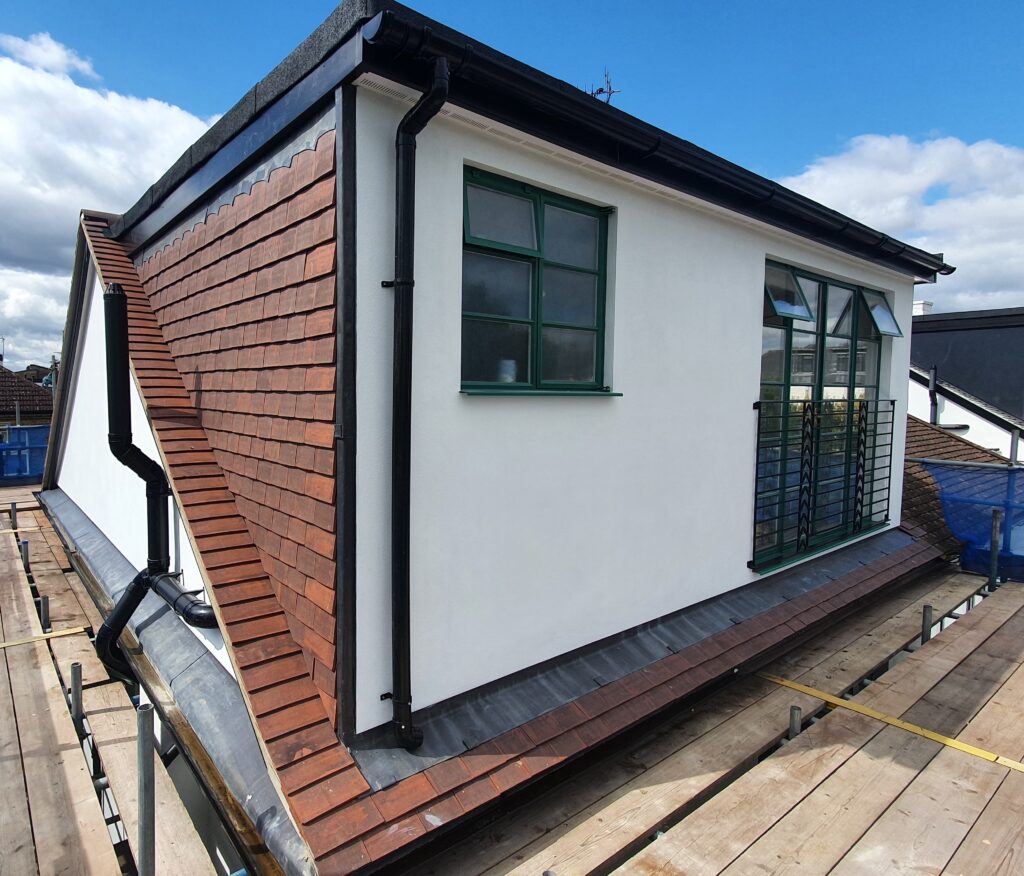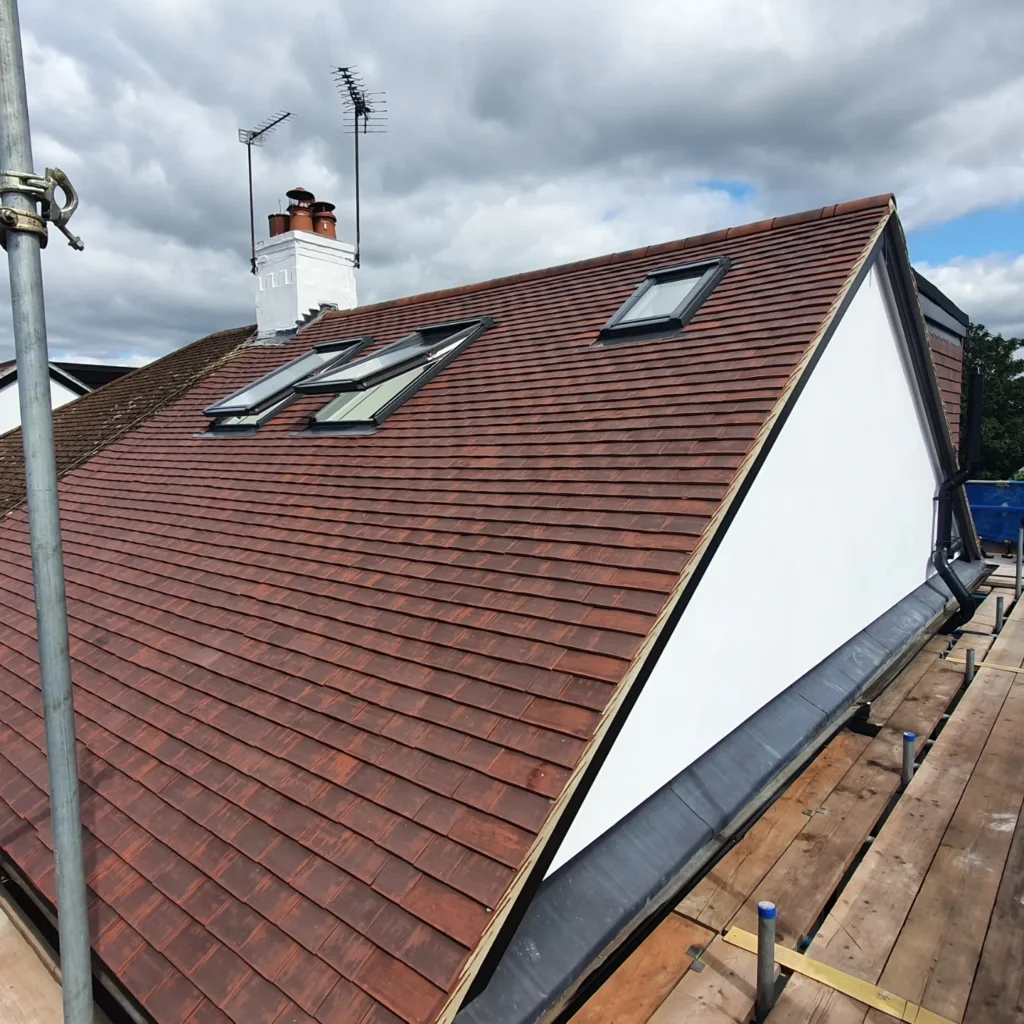Types of Loft Conversion
Hip to Gable Loft Conversion
Looking for an impressive idea to open up the expansion possibilities in your home? Then why not choose a hip to gable loft conversion service – the most convenient home remodelling alternative to gain extra usable space.
Maximize Your Space with a Hip to Gable Loft Conversion
A Hip to Gable Loft Conversion is a smart solution for homeowners looking to significantly expand their living space. By transforming the sloped side of your roof into a vertical wall, this conversion creates more headroom and usable floor area in your loft, particularly to accomodate a new loft staircase. Perfect for properties with a hipped roof, such as, end of terrace, bungalows, semi-detached or detached homes, a hip to gable conversion not only adds valuable space but also enhances the external look of your home.
Whether you’re considering a new bedroom, office, or playroom, this type of conversion can unlock the full potential of your attic, giving you the extra room you need while increasing your property’s value.
All our conversion projects are fully compliant with local building authority regulations. From the initial design phase to construction and final completion, our skilled team offers complete support, including drawings, structural plans, and a detailed schedule of works to ensure top-quality service. We provide a 10-year guarantee on all structural and roofing work and are fully insured up to £10 million. If planning permission is needed, we also guide you through the process to make everything as seamless as possible.
Marken Lofts are here to help with any issues that you may have. Try our new WhatsApp option using 07828 225 872. You can also fill out our enquiry form to get an instant quote.


What is a Hip to Gable Loft Conversion?
A Hip to Gable Loft Conversion is a popular home extension that involves altering the hipped end of a roof to create a vertical wall, known as a “gable.”
This process replaces the sloping roof on the side of the property with a straight wall, effectively extending the roof’s ridge to increase the amount of usable space in the loft. Hip to gable conversions are particularly common in semi-detached and detached houses with a hipped roof (sloping on all sides) but can also be performed on end-terrace properties.
Generally a rear dormer is added too, as you can see in the photos here,but this isn’t always necessary especially if there is ample height.
This type of loft conversion is ideal for homeowners who want to maximize headroom and floor space in their loft, transforming it into a versatile and functional new living area.
Benefits of a Hip to Gable Loft Conversion
A Hip to Gable Loft Conversion offers several benefits, making it an attractive choice for many homeowners:
- Increased Living Space: By extending the ridge line and creating a new gable wall, this conversion provides significantly more headroom for a staircase and usable floor space, perfect for larger rooms or multiple rooms.
- Enhanced Property Value: Adding an extra bedroom, bathroom, or office space can increase your home’s value substantially, making it a smart investment for the future.
- Improved Aesthetic Appeal: The gable wall adds a clean, modern look to the exterior of the property, which can enhance the overall curb appeal.
- Natural Light: The new gable wall is perfect for adding large windows, flooding the space with natural light and creating a bright, airy feel.
- Design Flexibility: With the additional space created by the conversion, you have greater flexibility to create a layout that suits your lifestyle needs, from a spacious master suite to a cozy home office.
Ideas for Your Hip to Gable Loft Conversion
A Hip to Gable Loft Conversion offers a range of possibilities. Here are some popular ideas to make the most of the extra space:
- Master Suite with Dressing Room: Transform your loft into a luxurious master suite, complete with a spacious bedroom, a walk-in dressing area, and a private en-suite bathroom.
- Home Office: Create a productive workspace away from the main living areas. Add a large desk, comfortable seating, and plenty of storage to design a dedicated home office with ample light.
- Guest Suite: Design a cozy guest suite for friends and family with a bedroom, bathroom, and small sitting area. This can offer guests privacy and comfort when they visit.
- Children’s Playroom and Study Area: Give your kids their own space with a playroom and study area. Add built-in shelves for toys, books, and supplies, and create a practical homework station.
- Multi-Purpose Room: The flexibility of a Hip to Gable Loft Conversion allows you to create a multi-purpose space, such as a combination home gym and yoga studio, or a crafting room that doubles as a quiet reading nook.
Do I Need Planning Permission?
Whether you need planning permission for a Hip to Gable Loft Conversion depends on a few factors. Many of these conversions can be completed under permitted development rights, meaning that planning permission is not required if specific conditions are met:
- The conversion does not extend the roof beyond the existing slope on the front of the property.
- The new gable and roof extension does not exceed a certain size limit (typically 40 cubic meters for terraced houses and 50 cubic meters for detached and semi-detached houses).
- The height of the conversion does not exceed the existing roof height.
- The materials used match the original house’s exterior appearance.
If your home is in a conservation area, is a listed building, or does not meet these criteria, you may need planning permission. Marken Lofts can help clarify the requirements for your specific project.
Building Regulations
Even if planning permission isn’t required, a Hip to Gable Loft Conversion must comply with building regulations to ensure the safety, durability, and energy efficiency of the space. Key areas covered by building regulations include:
- Structural Integrity: A structural engineers design must be strong enough to support the additional load of the converted space. Reinforcements to existing rafters are often necessary to accommodate the removing of purlins and fitting of Velux windows..
- Fire Safety: Fire safety measures, such as fire-resistant doors, smoke alarms, and designated escape routes, are required.
- Thermal Insulation: Proper insulation is essential for energy efficiency and comfort, especially as the new gable wall will need to meet insulation standards.
- Staircase Requirements: A permanent staircase that meets building code standards is required for safe and easy access to the loft space.
- Ventilation: Adequate ventilation is needed to prevent condensation, especially in areas with bathrooms or kitchens.
We will guide you through the building regulations process, arranging inspections at various stages of the project to ensure compliance.
Cost
The cost of a Hip to Gable Loft Conversion varies depending on factors such as location, size, and the level of customization. On average, a basic conversion can range from £40,000 to £65,000. The final cost will depend on the finishes, materials, and any additional features you choose, such as custom cabinetry, an en-suite bathroom, extra bedroom or upgraded windows.
While this initial investment may seem high, the long-term value added to your home can make it worthwhile. Not only does a Hip to Gable Loft Conversion increase your property’s resale value, but it also enhances the functionality and enjoyment of your living space.
Conclusion
A Hip to Gable Loft Conversion, especially with an added rear dormer is an excellent way to maximise the potential of your home by adding extra living space, boosting natural light, and increasing property value.
Whether you envision a serene master suite, a home office, a cozy guest room, or a versatile multi-purpose space, this type of loft conversion offers a flexible and stylish solution. With proper planning, adherence to building regulations, and a clear understanding of costs, a Hip to Gable Loft Conversion can transform your attic into a beautiful, functional new area that meets your lifestyle needs.
Why choose us to design and install your loft conversion?
With more than 28 years of practical experience, Marken Lofts specialise in delivering outstanding loft conversions. We take pride in our work and always strive to ensure our customers are truly happy and feel they have received exceptional value for their investment.
Our Commitment to Excellence
- Uncompromising Quality: Every project we undertake reflects our dedication to superior craftsmanship.
- Competitive Pricing: Offering exceptional value without compromising on excellence.
- Fully Insured: For your peace of mind, our team is fully insured up to £2 million.
- Immaculate Cleanliness: We maintain the highest standards of tidiness on every job.
- Transparent Pricing: Clear, upfront costs with no hidden surprises—know exactly what to expect.
- 10-Year Work Guarantee: Confidence and peace of mind with every project.
- End-to-End Project Management: From concept to completion, we handle every detail for a seamless loft conversion experience.
Our 10-Year Guarantee reflects the confidence we have in our skilled team to deliver outstanding results every time.
Areas we work in
We deliver exceptional loft conversions across North London, East London, and Central London. Get in touch if you would like to confirm we cover your area, or click on the map for more information.
For advice on a loft conversion or for a free survey call 0800 111 4883 or enquire online:
"*" indicates required fields
Types of Loft Conversions
Highly distinctive loft conversion services to enhance your space, whatever your needs.
FAQ
How long will the consultation and survey take?
Generally, we allocate approximately 1-2 hours for the consultation and survey process, but its often is no longer than 40 minutes. For larger or more intricate projects, it may take slightly longer to ensure we capture all necessary information accurately. Rest assured, our goal is to provide a comprehensive evaluation while respecting your time constraints. If time is precious and you just want a price for the works, If you fill in our instant quote form, this will eradicate the need for an initial survey.
Do I need planning permission for a loft conversion?
Whether you’ll need planning permission or if your project falls under permitted development largely depends on various factors such as the type of property you own, its location, and the specific regulations set by your local planning authority. Typically, many loft conversions in London fall under permitted development rights, meaning you can carry out the conversion without the need for planning permission as long as certain criteria are met. However, it’s crucial to consult with a professional architect or a loft conversion specialist to assess your individual circumstances. Factors such as the size and shape of your loft, the proposed alterations, and any previous extensions or conversions already carried out on your property can affect whether your project qualifies for permitted development or requires planning permission.
How much does a loft conversion cost?
Loft conversion costs vary depending on factors such as the size and complexity of the project, the materials used. On average, a basic loft conversion can cost between £20,000 to £55,000, but this can increase significantly for larger or more complex projects.
How long does it take to complete a loft conversion?
The duration of a loft conversion depends on factors such as the size of the loft, the complexity of the design, and any unforeseen issues that may arise during construction. On average, we complete a loft conversion 6 weeks or less.
Will a loft conversion add value to my property?
Yes, a well-executed loft conversion can significantly increase the value of your London property. It not only provides additional living space but also enhances the overall appeal and functionality of your home, making it more attractive to potential buyers. What’s more, the enhanced value often exceeds the initial investment made in the loft conversion.
What type of loft conversion is best suited for my home?
The most suitable type of loft conversion for your London home depends on factors such as the existing roof structure, available space, and your specific requirements. Common types of loft conversions include dormer, Velux, hip-to-gable, L-Shape and mansard conversions. Contact us and we shall help determine the best option for your property.
Are there any building regulations or safety standards I need to adhere to when converting my loft in London?
Converting your loft requires strict adherence to building regulations and safety standards to guarantee structural integrity and compliance with fire safety regulations. It’s important to note that adding another storey to your home may necessitate upgrades to existing doors to meet fire safety requirements. As regulations are subject to change, partnering with a trusted company that emphasizes safety and compliance is paramount to ensure your project meets all necessary standards.
Do I need to inform my neighbors or obtain their consent before proceeding with a loft conversion?
Before commencing your loft conversion project, it’s important to consider whether any of your external walls are shared with a neighbor. In such cases, you’ll likely need to establish a party wall agreement. This legal agreement outlines the rights and responsibilities of both parties regarding construction work that impacts a shared wall or boundary. While this process can sometimes be straightforward, involving the signing of a party wall agreement form, your neighbor may opt to consult with a qualified party wall surveyor, which may incur additional costs on your part. It’s advisable to discuss this matter with your neighbor and seek professional advice to ensure a smooth process.

